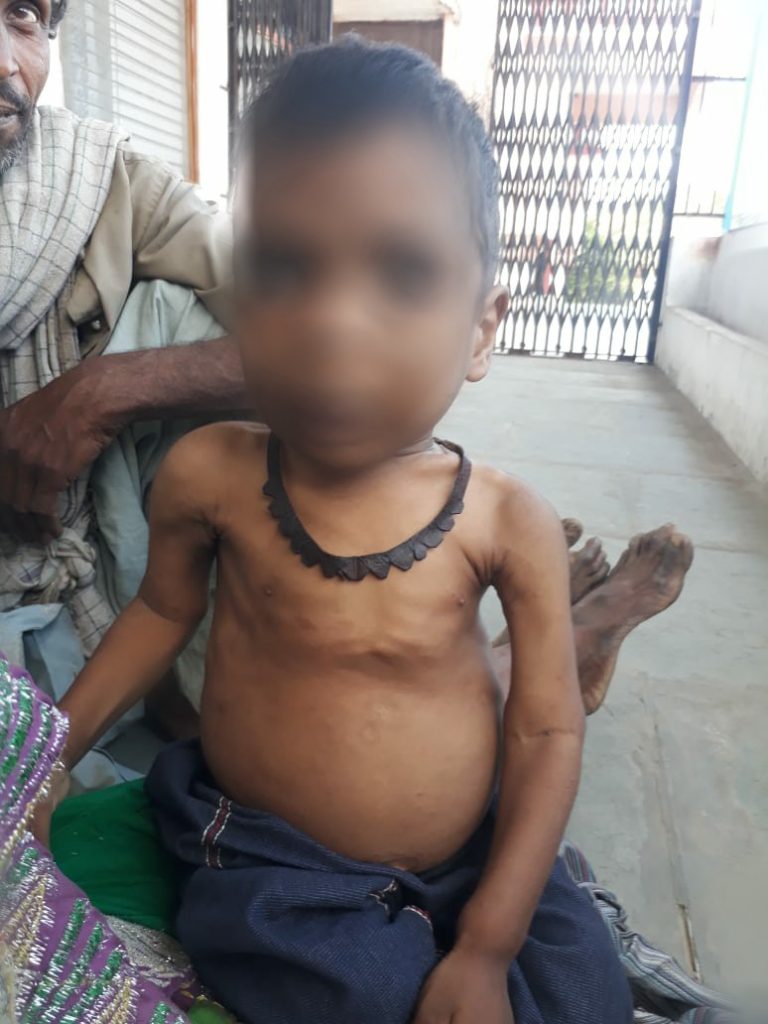I distinctly remember my first visit to the Phulwaris (crèches run by Amrit clinics) in Southern Rajasthan. Before the visit, I had romanticised the creches, in my head, with the images of kids running around, shouting, playing without a care in the world like one does during their childhood.
Upon arriving, I learned to my dismay that the scene in my head was nowhere close to the reality. There were no kids playing in the verandah, there was no sound of kids reciting rhymes. Instead, inside the house, was a room occupied by nearly a dozen children, their age ranging from 6 months to 3 years, sitting quietly on one carpet. All looking frail and passive, so much so that one of the child had his face full of flies sitting on it and still did not move to shoo them off. Among them was a baby girl aged 10 months, who appeared to be no less than 3 months old. She was suffering from both Severe Acute Malnutrition and Tuberculosis. It was an image that has distraught me till date.
Malnutrition to me was just another term mentioned in my class 6th science textbook, with an image of a boy with a swollen belly. After this encounter and the passing days, the textbook image that I had seen has timely came out in reality in front of me. In the tribal areas of southern Rajasthan, where I currently work with Basic Healthcare Services, the levels of malnutrition are very high amongst children. And there are a few reasons I have observed why malnutrition is prevalent in the region.
- Acceptance of the problem
When one accepts there is problem, the battle is half won. The battle against malnutrition starts with the failure of acceptance. Parents fail to accept that there is something wrong with my child. The fact that the kid is not healthy is something hard for them to ingest which from their perspective is not incorrect. After all, there is no benchmark for comparison, as there is no kid around them or in their village who is healthy.
- Unawareness and unavailability of nutritious food
Mothers are not aware that they should start complementary feeding for their child after 6 months. Most of them continue to only feed breast milk till the age of 1 year. Whereas, after 6 months exclusive breast milk no longer meets the required nutritional level of the child and complementary foods must be added to their diet. Few of them when asked about what food do they give to their child, the normal answers we get is a ‘roti ka tukda’, which is usually a wheat or maize roti that the child is given which is dropped innumerable times on the ground causing it to get filthy and unsafe for consumption. I used to very casually suggest the mothers what they can feed their kids, only to realize that they barely even have any of the food items stocked or the ability to purchase them. There is no milkman who brings in milk, no grocery store at the corner with all the required food items and no vegetable seller who comes with his stall every evening to sell. One gets milk only if they have cow or buffalo, grocery store is approx. 10 km away from home and you will get vegetables everyday only if you grow them.
- Myths associated with food
In addition to the limited and scarce food options there are myths revolving around the food items that are available. It was surprising to know that tribal people here don’t eat eggs. People consume egg only when they have a bone injury and that also is consumed raw, thus building up more dislike amongst the people. Myths like eating eggs turns women into witch or ‘dayan’ further encourage this dislike. One can also see the growing influence of higher castes on the food habits. Tribals have stopped consuming non vegetarian food items under religious beliefs. All these beliefs restricts the available nutrient intake for consumption. Thus leading to poor nutrition level and health among the kids.
- Surging responsibilities on the mothers
The amount of time available at disposal for childcare in a community that has high number of male migrating to nearby cities for work, there is a huge burden on the women in the family to take up the responsibilities of the household. She has to look after the farming that is carried out in the limited land holdings by the family, take care of the cattle, fetch firewood from the jungles and also look after the kids. Unfortunately, in all the daily chores, farming and cattle care comes on a priority than childcare. There are instances when kids are left unattended with the cattle or tied to the charpoi in the houses when their mothers are away for work.
Why should we all worry about it? Severe acute malnutrition is a major cause of death in children under 5, and its prevention and treatment is critical to child survival and development. The damage to physical and cognitive development during the first two years of a child’s life is largely irreversible. Malnutrition also leads to poor school performance, which can result in future income reduction. Adults who were undernourished as children are at risk of developing diseases in future.
To combat the critical issue of malnutrition, many organisations are undertaking anti-malnutrition programs. The Phulwaris run by BHS provide the children with a safe space while their parents work, three nutritious meals a day, and engagement in the form of play to stimulate their cognitive learning. Children aged from 6 months to 3 years are enrolled here. Specifically the target group is of this age as the maximum brain development happens from 6 month to 2 years and when we talk about govt schemes, Anganwadis enroll kids from the age of 3, till which the maximum damage has happened.

There are a lot of things that I have learnt from my time here about nutrition. I always thought education was a key tool to fight against poverty. Every icebreaker question to a child I met was “Do you go to school or not?” This has drastically changed since after my visit to Phulwaris only to realize that the child has to first be alive and not die hungry.
This is vital in order to have have a health developed brain and a healthy body to support this. These early years not only affects their physical growth and cognitive and social development potential, but also sets a critical foundation for their entire life-course. From that day first day of visit to now, I am now more concerned if the child I met today has had food or not. School to me now comes much later in the picture once he is salubrious.
Note: The names and pictures have been put up with consent of parents/guardians.




There is a consistent growth in the blogs – in terms of insights, expression and articulation. Really really glad to read this. Write oftener :-)!
Thank you Anupama 🙂
Thanks for writing this. Its an eye-opener and very informative of the ground issues.
All this while, knowing more about malnutrition and it’s effects was a big learning for me.